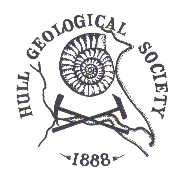
TRANSACTIONS OF THE HULL GEOLOGICAL SOCIETY
NOTES ON EXCURSIONS, 1925-6. W. C. ENNIS, B.Sc.
It
would be a real service to local geology if members finding new or doubtful
fossils would allow the writer to obtain expert determination of the species
for record. Many important fossils have been found, and have subsequently
disappeared, leaving no definite information.
South Cave.--There are some new exposures
in tile Inferior Oolite to the west of the railway station, near the line. We
obtained Lima strigillata, Eopecten abiectus, Camptonectes lens, Pinna
cuneata, and an undetermined echinoderm.
North Grimston.
--In the white flaky 'cement beds' a fine belemnite, and an impression of a
fine-ribbed ammonite, were noted.
CRETACEOUS (Roughly Zoned).
High Stacks.--After diligent search, two
poor examples of Actinocamax westphalicus were found, one practically
at the level of the highest flints, and one about 10 feet below in flinty
chalk (M. ca. zone). A
peculiar structure resembling 'cone-in-cone,' on a gigantic scale, was noticed
in the cliffs to the southwards, huge cones of chalk standing out from the
cliff face. Photographs are to be taken.
At a small pit near the crossing of the
Melton road and the Kirkella to Raywell road, small examples of Echinocorys
were found, indicating another exposure of the base of the
cortestudinarium zone.
South Ferriby (Lincs.).-- A new quarry, nearer to South Ferriby village, has been
opened, showing the Black Band with beds above and below. Numerous well-marked
step-faults occur involving the Black Band. A small sharp fish tooth was found
near the band. A large 2-feet ammonite was photographed by Mr. Stather. On the
beach near the ietty is an interesting exposure of white, grey and red chalk.
Fossils are numerous. Ten large ammonites, badly preserved, averaging 18
inches wide, outer coil 6 inches, and 2½ inches thick, were noticed in the
grey chalk. Other smaller ammonites, 9 inches, 6 inches and 2½ inches in
diameter, have been obtained. The naming of the rapidly-increasing number of
local chalk ammonites is an urgent question. Other fossils were :--Holaster
subglobostts, Inoceramus pictus?, Serpula, Ostrea, Rynchonella , and a
large Pecten,
South Ferriby.-- Sub-Cretaceous (Lower
Kimmeridge) Clays: Rasenia (ammonite, young specimens), etc. See
special report.
Millington Dale.--There is a good exposure
of red chalk about 2o feet above the road near the springs.
CLACIAL DEPOSITS.
High Stacks.--Many large boulders occur in
a sheltered bay and on the scars. A 3-foot cube of Shap granite was noted.
Cottingham.--The floor of the new gravel
pit consists of dark red stoneless clay (? redistributed Hessle boulder clay).
The sands and gravels contain only cockle and oyster shells; no Kelsey Hill
types; exceptional numbers of B. mucronata are present.
Paull.-- Large new pit on road passing
Paull Church. Tellina, Cardium, Ostrea abundant; Nassa, Bulla,
rare. No Corbicula. Bones of Bos primigenius and tooth of
mammoth.
Brandesburton.-- Great activity in digging for gravel;
many new exposures. Shells rare :--Cardium, Ostrea, Tellina, mostly
broken. An 'ankle bone' of the bison was obtained at Coney Garth.
Catwick.-- Large gravel pit : gravel
coarse, large stones -- chalk, black flint, rhomb-porphyry, augite-syenite,
Cheviot porphyrite. Shells rare: --Cardium and Tellina. To date,
no Corbicula has been found except at Burstwick and Kelsey Hill, though
special search has been made.
Aldbrough.--Boulder clay ; mammoth tooth found.
Skipsea -- A chalk boulder in the clay
yielded B. mucronata. Peat was noted, with trunks of trees, nuts, etc.
A clay containing shells was noted.
Hornsea.--Peat and finely laminated clays
were well exposed. The peat contained the peacock-blue spots of vivianite.
Copyright
- Hull Geological Society 2021
Registered
Educational Charity No. 229147
Home

